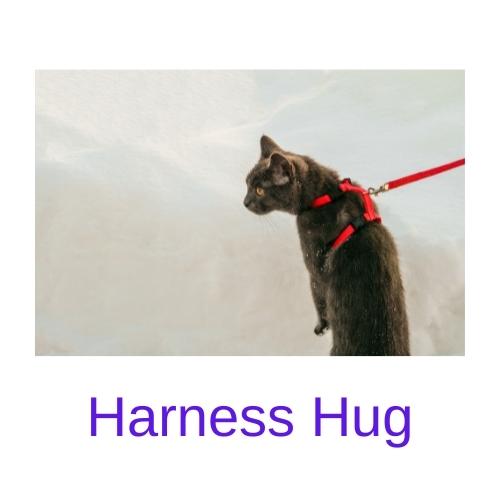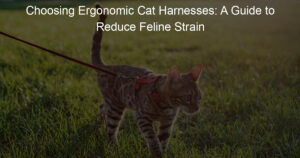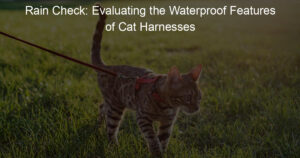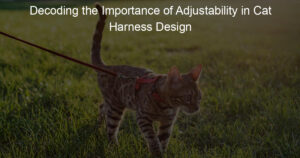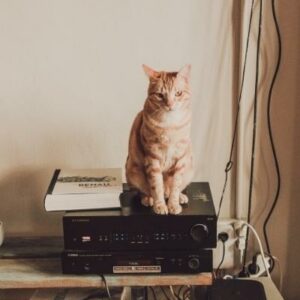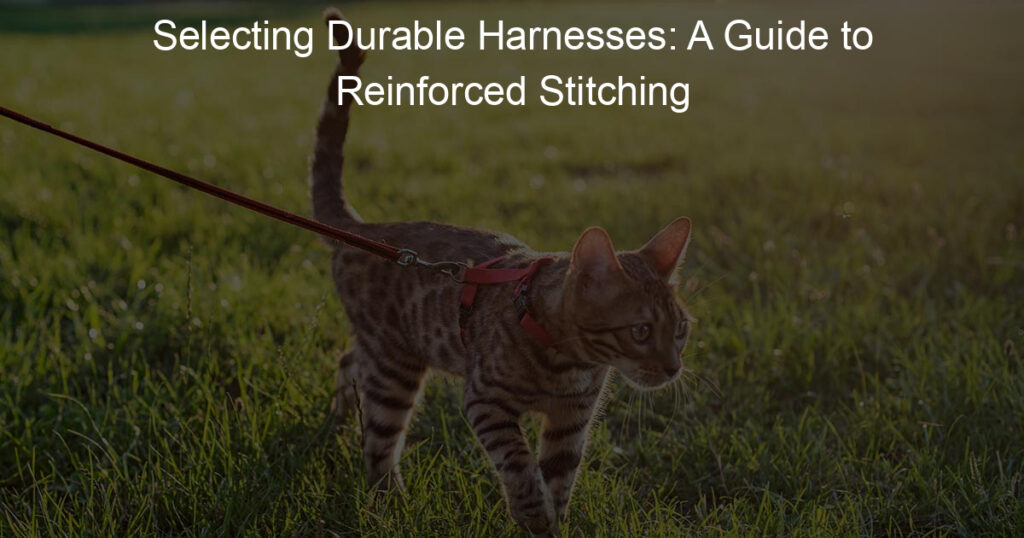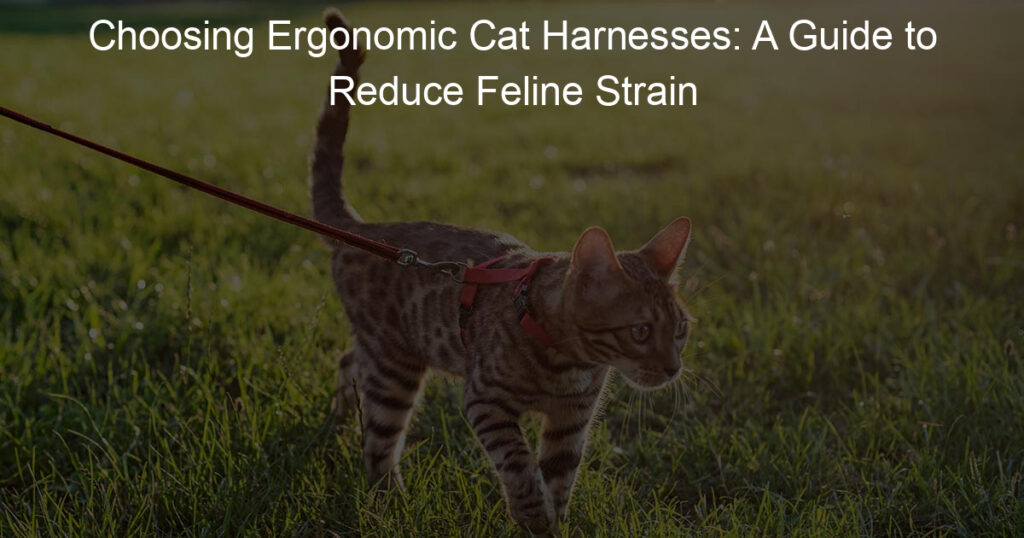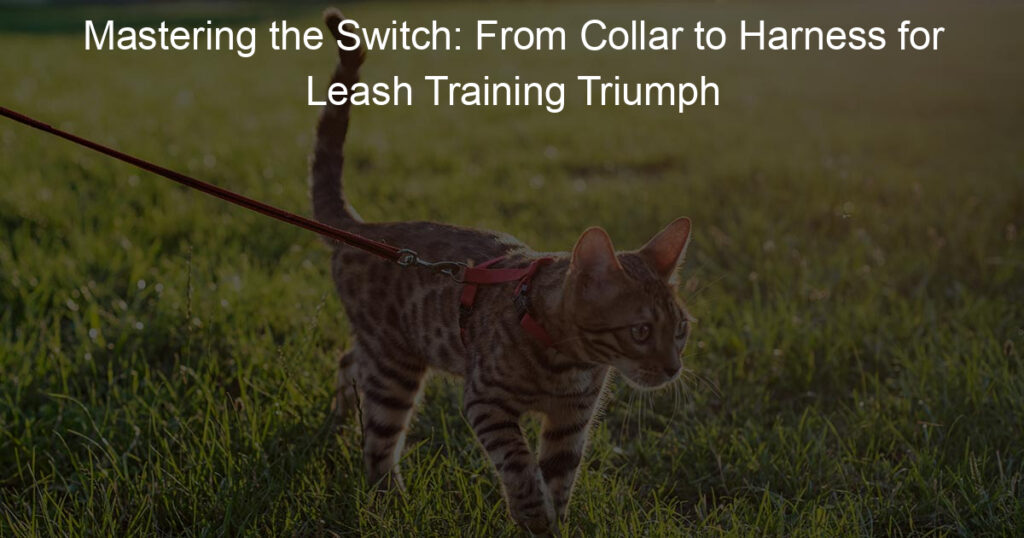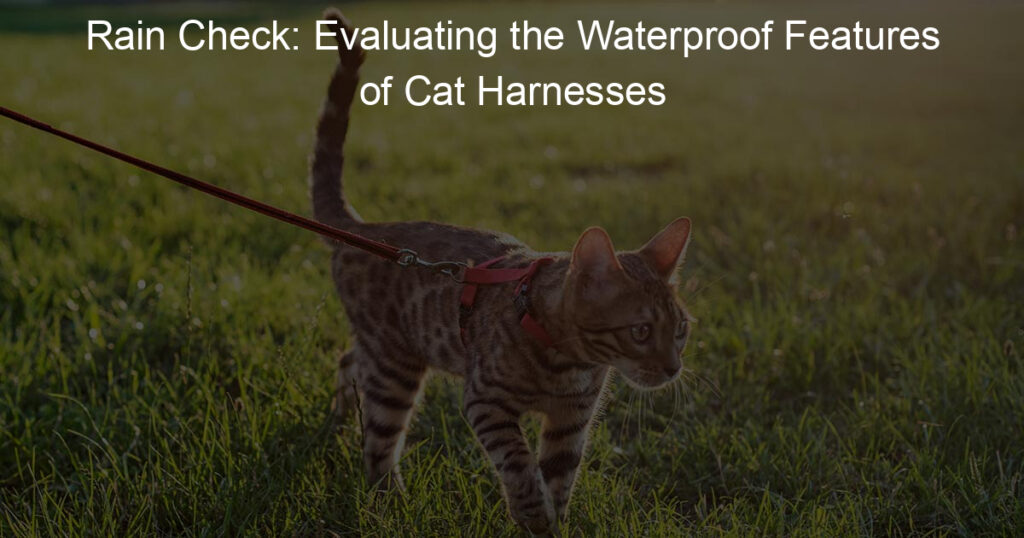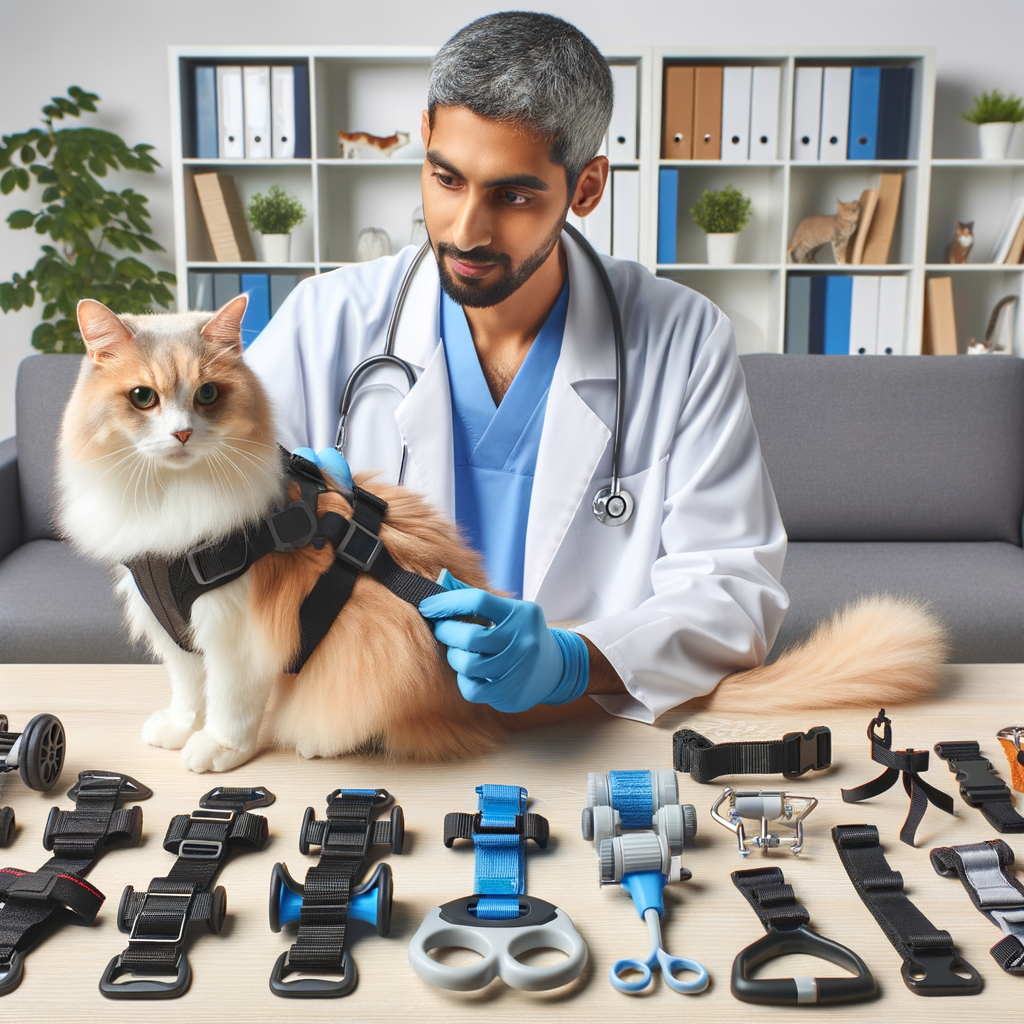
Understanding Cat Harnesses: An Introduction
Have you ever wondered about the best ways to keep your feline friend safe and secure? One of the answers to this is a cat harness. In this article, we will delve into the world of cat harnesses and understand their importance.
- What are cat harnesses?
- The importance of cat harnesses for support
A cat harness is a device made of straps that fit around a cat’s body. It’s different from a collar because it doesn’t just go around the neck. Instead, it wraps around the chest and sometimes the belly too. This design helps distribute pressure evenly across the cat’s body, making it safer and more comfortable for the cat.
Cat harnesses play a crucial role in supporting your cat, especially when you’re out and about. They provide safety and security, preventing your cat from running off into potentially dangerous situations. Harnesses also offer support for older cats who may have mobility issues. They can help distribute weight evenly, making it easier for your cat to move around.
Now that we’ve introduced cat harnesses and their importance, let’s delve deeper into how they can be beneficial for senior cats, and explore other pet harnesses and mobility aids that can support your feline friend’s health and well-being.
The Role of Harnesses in Senior Cat Care
As our beloved feline friends age, their needs change. One of the ways we can provide them with the best care is by understanding the role of harnesses in senior cat care.
Why Senior Cats Need Extra Support
Just like humans, cats can experience mobility issues as they age. These issues can make it difficult for them to move around as freely as they once did. But don’t worry, there are ways to help them, and one of the most effective solutions is the use of a harness.
- Age-related mobility issues in cats
- How harnesses can help with these issues
As cats grow older, they may start to show signs of slowing down. They might not jump as high, run as fast, or play as much. Some cats may even develop arthritis, a condition that causes pain and inflammation in the joints. According to the Cornell University College of Veterinary Medicine, up to 90% of cats over the age of 12 suffer from arthritis. This can make even simple tasks like climbing stairs or jumping onto a favorite perch challenging and painful.
A harness can provide the extra support that senior cats need. It can help distribute their weight evenly, reducing the strain on their joints. A harness can also give you more control when assisting your cat, making it easier to help them navigate tricky areas like stairs. Plus, a harness can provide a sense of security for your cat, helping them feel more confident as they move around.
Remember, every cat is unique, and what works for one might not work for another. It’s important to monitor your cat’s behavior and consult with your vet to find the best solution for your furry friend.
Choosing the Right Harness for Your Senior Cat
Choosing the right harness for your senior cat is a critical decision. It can significantly impact your cat’s comfort and mobility. Let’s explore some key factors to consider and some examples of good harnesses for elderly cats.
- Factors to Consider When Choosing a Cat Harness
- Size and Fit: The harness should fit your cat snugly but comfortably. An ill-fitting harness can cause discomfort or even injury.
- Material: The harness should be made of soft, durable material that won’t irritate your cat’s skin.
- Adjustability: As your cat ages, its size and shape may change. An adjustable harness can accommodate these changes.
- Easy to Put On and Take Off: Senior cats may not have the patience or flexibility for a complicated harness. Choose a design that’s easy to put on and take off.
- Examples of Good Harnesses for Elderly Cats
- The Comfort Fit Harness: This harness is made of soft, breathable mesh and has adjustable straps for a custom fit.
- The Easy Walk Harness: This harness has a front-clip design that discourages pulling, making it easier for you to control your cat.
- The Padded Vest Harness: This harness provides extra padding for comfort, and its vest design distributes pressure evenly across the cat’s body.
When selecting a harness for your senior cat, you need to consider several factors. These include:
Here are a few examples of harnesses that are well-suited for senior cats:
Remember, every cat is unique. What works for one senior cat may not work for another. It’s important to consider your cat’s specific needs and preferences when choosing a harness.
Understanding the Benefits of Senior Cat Harnesses
One of the significant benefits of senior cat harnesses is their role in improving mobility. Let’s delve into this in more detail.
Improved Mobility
As cats age, their mobility can become limited due to various health issues. Harnesses designed specifically for senior cats can help them move around more easily and maintain their independence.
- How harnesses can help senior cats move around more easily
- Case study: An elderly cat’s improved mobility with a harness
A well-fitted harness can provide the necessary support for a senior cat’s body, reducing the strain on their joints and muscles. This support can make movement less painful and more comfortable, enabling them to continue exploring their environment and engaging in their favorite activities.
Consider the case of Whiskers, a 15-year-old cat who had started to slow down due to arthritis. His owner decided to try a senior cat harness, and the results were remarkable. With the harness’s support, Whiskers was able to move around more easily, and his owner noticed a significant improvement in his mood and activity levels. This case study illustrates the potential benefits of harnesses for senior cats’ mobility.
In conclusion, a harness can be a valuable tool in maintaining and improving the mobility of senior cats. It’s a simple solution that can greatly enhance their quality of life.
Increased Comfort
- The Design Features of Harnesses That Make Them Comfortable for Senior Cats
- Why Comfort is Crucial for Senior Cat Care
When it comes to senior cats, comfort is a top priority. The design of a cat harness plays a significant role in providing this comfort. Harnesses designed for senior cats often feature soft, padded materials that prevent any discomfort or chafing against their skin. The adjustable straps allow for a perfect fit, ensuring the harness is neither too tight nor too loose. Some harnesses even come with mesh designs for better ventilation, keeping your cat cool and comfortable.
Moreover, the weight distribution in these harnesses is also a crucial design feature. Unlike collars, which can put pressure on a cat’s neck, harnesses distribute the weight across the cat’s body. This reduces strain on any one area, making it more comfortable for your senior cat to move around.
Comfort is not just about making your senior cat feel good; it’s a vital aspect of their overall health and well-being. As cats age, they may develop arthritis or other joint issues, making movement uncomfortable or even painful. A comfortable harness can help alleviate these issues by providing support and reducing pressure on their joints.
Furthermore, a comfortable cat is a happy cat. When your senior cat feels comfortable, they are more likely to engage in physical activity, which is essential for maintaining their health and mobility. In contrast, discomfort can lead to stress, which can have negative impacts on their health, including decreased immune function and increased risk of illness.
Thus, investing in a comfortable harness is not just about pampering your cat; it’s about providing them with the care they need as they age.
Other Pet Harnesses for Support
While we have been focusing on harnesses for senior cats, it’s important to remember that other pets can also benefit from the support provided by harnesses. In this section, we will explore the specifics of support harnesses for dogs.
Support Harnesses for Dogs
Dog harnesses are designed differently than cat harnesses, and they can be particularly beneficial for senior dogs. Let’s delve into these differences and benefits.
- How dog harnesses differ from cat harnesses: Unlike cat harnesses, dog harnesses are often larger and more robust, designed to handle the greater strength and size of dogs. They are typically built with a focus on the chest and back area to distribute pressure evenly when the dog pulls on the leash. Cat harnesses, on the other hand, are smaller and lighter, focusing more on the neck and shoulder area to prevent cats from slipping out.
- Benefits of support harnesses for senior dogs: As dogs age, they may experience joint pain, arthritis, or mobility issues. A support harness can help alleviate these problems by providing additional support and stability. It can also make it easier for pet owners to assist their dogs in standing up, climbing stairs, or getting in and out of vehicles. In fact, a study by the American Veterinary Medical Association found that the use of support harnesses significantly improved the quality of life for senior dogs with mobility issues.
In conclusion, while cat and dog harnesses may look similar, they are designed with the specific needs of each animal in mind. And just like with cats, harnesses can play a crucial role in supporting the health and mobility of senior dogs.
Support Harnesses for Other Pets
While cats and dogs are the most common pets to use support harnesses, other pets can also benefit from these helpful aids. Let’s explore some examples and key takeaways about pet harnesses for support.
- Examples of other pets that can benefit from support harnesses
- Rabbits: Older rabbits or those with mobility issues can use support harnesses to help them move around more comfortably.
- Ferrets: These energetic creatures can also benefit from harnesses, especially if they have health conditions that affect their mobility.
- Guinea Pigs: These small pets can also use harnesses to support their movement, particularly if they are older or have health issues.
- Key takeaways about pet harnesses for support
- Enhanced Mobility: Harnesses can significantly improve a pet’s mobility, especially for those with health conditions or aging pets.
- Improved Quality of Life: By aiding mobility, harnesses can help pets maintain a higher quality of life as they age or deal with health issues.
- Safety: Harnesses provide a safe way to assist pets in moving around, preventing potential injuries.
Support harnesses are not just for cats and dogs. They can also be beneficial for other pets, including:
Here are some important points to remember about pet harnesses for support:
In conclusion, support harnesses can be a valuable tool for a variety of pets, not just cats and dogs. They can enhance mobility, improve quality of life, and provide a safe way to assist pets in their daily activities. Remember to consult with a veterinarian before introducing a support harness to ensure it’s the right fit and solution for your pet’s needs.
Additional Cat Mobility Aids
While harnesses are a great tool for aiding your cat’s mobility, there are other options available as well. Let’s take a closer look at some additional aids that can help improve your cat’s mobility and overall quality of life.
Ramps and Steps
As cats age, they may find it difficult to jump or climb like they used to. This is where ramps and steps can come in handy.
- How ramps and steps can aid in cat mobility
- Choosing the right ramp or steps for your cat
Ramps and steps can provide a gentle incline for your cat to navigate, making it easier for them to reach their favorite spots. This can be particularly beneficial for cats with arthritis or other mobility issues. For example, a cat with arthritis may find it painful to jump onto a bed or couch. A ramp or steps can make this task much easier and less painful.
When choosing a ramp or steps for your cat, there are a few things to consider. Firstly, the size of the ramp or steps should be appropriate for your cat. It should be wide enough for your cat to comfortably walk up and down, and the steps should be low enough for your cat to easily step onto. Secondly, the material of the ramp or steps is also important. It should be sturdy and non-slip to ensure your cat’s safety. Lastly, consider the location where you will place the ramp or steps. It should be in a quiet, comfortable area where your cat frequently spends time.
Remember, every cat is unique and what works for one may not work for another. It’s always best to consult with your vet before introducing any new mobility aids to your cat’s routine. With the right support and care, your cat can continue to enjoy their golden years in comfort and happiness.
Orthopedic Beds
Orthopedic beds are a fantastic addition to your senior cat’s comfort and health. Let’s delve into the benefits of these beds and what to look for when buying one.
- The Benefits of Orthopedic Beds for Senior Cats
As cats age, they may develop joint issues such as arthritis. This can make their usual sleeping spots uncomfortable. An orthopedic bed provides the necessary support and comfort for your senior cat, reducing the strain on their joints.
Orthopedic beds are designed with high-quality, dense foam that contours to your cat’s body, providing relief for aching joints. This can significantly improve your cat’s quality of sleep, which is crucial for their overall health and well-being.
Moreover, orthopedic beds can help regulate your cat’s body temperature. They are often made with materials that keep your cat warm during cold seasons and cool during hot seasons. This is especially beneficial for senior cats as they can be more sensitive to temperature changes.
- What to Look for When Buying an Orthopedic Bed
When buying an orthopedic bed for your senior cat, there are several factors to consider:
| Factor | Description |
|---|---|
| Size | Choose a bed that is large enough for your cat to stretch out comfortably, but not so large that it loses its sense of security. |
| Material | The bed should be made of high-quality, dense foam that can provide the necessary support for your cat’s joints. It should also be durable and easy to clean. |
| Design | Consider a bed with raised edges if your cat likes to curl up. If your cat prefers to stretch out, a flat bed may be more suitable. |
| Temperature Control | Look for a bed made with materials that can help regulate your cat’s body temperature. |
Remember, the right orthopedic bed can greatly improve your senior cat’s quality of life. It’s an investment in their comfort and health.
Conclusion: Harnesses for Aging Cats and Overall Cat Health
As we draw this discussion to a close, it’s essential to recap the key points and insights we’ve gathered about the role of harnesses in senior cat care and overall cat health. Let’s delve into a summary of our findings and final thoughts.
- Recap of the Importance of Harnesses for Senior Cats
- Final Thoughts on Cat Health and Harnesses
Throughout this article, we’ve highlighted the critical role that harnesses play in the lives of aging cats. Harnesses provide much-needed support for senior cats, helping them maintain mobility and independence. They are instrumental in managing conditions such as arthritis, which are common in older cats. By using a harness, you can help your feline friend navigate their environment with less pain and more confidence.
Overall, harnesses are more than just a tool for outdoor adventures. They are a vital component of senior cat care, contributing significantly to the overall health and wellbeing of your feline companion. Harnesses can help reduce the risk of injuries, manage chronic conditions, and improve the quality of life for your aging cat.
Remember, every cat is unique, and what works for one might not work for another. It’s always best to consult with your veterinarian before introducing a harness or any other mobility aid to your cat’s routine. With the right approach, a harness can make a world of difference in your senior cat’s life.
As we conclude, let’s remember that our furry friends rely on us for their care and comfort. By understanding and implementing the use of harnesses, we can ensure they continue to live their golden years with grace and dignity.
